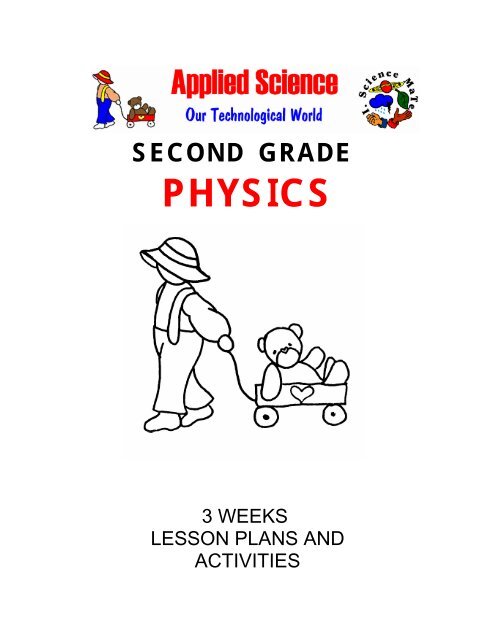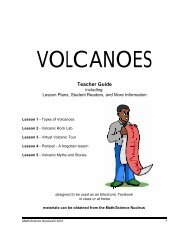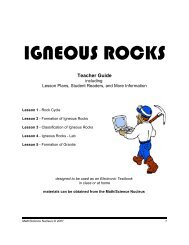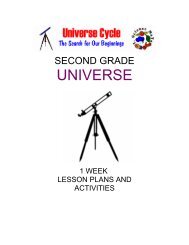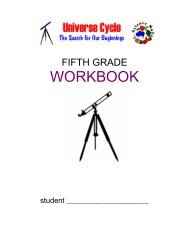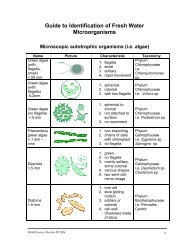Second grade physics - Math/Science Nucleus
Second grade physics - Math/Science Nucleus
Second grade physics - Math/Science Nucleus
Create successful ePaper yourself
Turn your PDF publications into a flip-book with our unique Google optimized e-Paper software.
SECOND GRADE<br />
PHYSICS<br />
3 WEEKS<br />
LESSON PLANS AND<br />
ACTIVITIES
APPLIED SCIENCE<br />
OVERVIEW OF SECOND GRADE<br />
SCIENCE AND MATH<br />
WEEK 1.<br />
PRE: Exploring perception.<br />
LAB: Experimenting and predicting volume, weight, and length.<br />
POST: Estimating and gathering data.<br />
WEEK 2.<br />
PRE: Comparing and contrasting two and three dimensional objects.<br />
LAB: Recognizing and comparing shapes.<br />
POST: Exploring unit cells to create patterns.<br />
WEEK 3.<br />
PRE: Investigating symmetry.<br />
LAB: Comparing symmetry in nature.<br />
POST: Discovering tessellations.<br />
PHYSICS<br />
WEEK 4.<br />
PRE: Describing the physical world.<br />
LAB: Exploring the <strong>physics</strong> behind toys.<br />
POST: Investigating how things work.<br />
WEEK 5.<br />
PRE: Comparing different forms of energy.<br />
LAB: Investigating different forms of energy.<br />
POST: Exploring nuclear, heat, and chemical energy.<br />
TECHNOLOGY<br />
WEEK 6.<br />
PRE: Investigating everyday simple machines.<br />
LAB: Investigating machines that produce work.<br />
POST: Comparing machines that produce energy.<br />
WEEK 7.<br />
PRE: Exploring technology.<br />
LAB: Investigating computer technology.<br />
POST: Comparing technologies used in the entertainment industry.<br />
BUILT ENVIRONMENT<br />
WEEK 8.<br />
PRE: Comparing different energy machines.<br />
LAB: Investigating how solar energy produces power.<br />
POST: Contrasting different forms of energy.<br />
<strong>Math</strong>/<strong>Science</strong> <strong>Nucleus</strong> ©1990,2000 2
APPLIED SCIENCE - PHYSICS (2A)<br />
PRE LAB<br />
OBJECTIVES:<br />
1. Defining <strong>physics</strong>.<br />
2. Describing the physical world.<br />
VOCABULARY:<br />
<strong>physics</strong><br />
science<br />
MATERIALS:<br />
toys<br />
balls<br />
anything in your classroom to help illustrate <strong>physics</strong><br />
BACKGROUND:<br />
Students observe <strong>physics</strong> in the<br />
classroom.<br />
Physics is the study of matter and energy and is the root of every field of science.<br />
It underlies the understanding of all phenomena. Specifically as a science, <strong>physics</strong> is<br />
related to the phenomena of motion, force, energy, matter, sound, electricity, magnetism,<br />
light, and the atom and nucleus. Physics is also an underlying part of both physical,<br />
geological, and biological sciences. Physics is the present day equivalent of what used to<br />
be called natural philosophy from which most of present day science arose. The study of<br />
these topics makes up that which is called <strong>physics</strong>.<br />
The field of <strong>physics</strong> is generally broken into discrete categories of mechanics, heat,<br />
energy, sound, light, magnetism, electricity, optics and those of atomic or nuclear structure.<br />
These traditional topics reflect the historical development of <strong>physics</strong> throughout the years<br />
in search for a unified field theory. A unified theory which can explain how all these forces<br />
and energy, in the Universe, work together. The search of a grand unified theory of all<br />
matter, sometimes border on ingenuity than it does on concrete facts. Recent theoretical<br />
investigations point to symmetry as an underlying law of <strong>physics</strong>. This "supersymmetry"<br />
could have been broken as the Universe evolved. Physicists are now trying to put the<br />
symmetry back together. This almost sounds fun!<br />
Throughout this program, students are exposed to different components of the<br />
physical world. Point out that <strong>physics</strong> is all around us. We see, feel, touch, and perform<br />
<strong>physics</strong> everyday. We just don't think about it! Physics explains what is being done. The<br />
more a child observes, the more that child understands what is happening. For example,<br />
children throw balls which seems a natural act, but explaining why the ball doesn't go into<br />
outer space requires a physical explanation. The Earth's gravity pulls the ball back to<br />
<strong>Math</strong>/<strong>Science</strong> <strong>Nucleus</strong> ©1990,2000 3
Earth. Physics develops explanations why the world works the way it does.<br />
PROCEDURE:<br />
1. Ask students if they have heard the word "<strong>physics</strong>?" Instruct them to attempt<br />
to give a definition before you explain.<br />
2. Show students examples of <strong>physics</strong> in everyday life. Listed below are some<br />
examples. Be a little dramatic by making a book smash on the floor and ask students<br />
why? (Gravity.) In many cases, answers are not as important as having the students ask<br />
questions about their physical surroundings. Below are a few words and examples you<br />
can use. In later <strong>grade</strong>s, students will have developed the tools necessary to put together<br />
all the pieces of <strong>physics</strong> and develop a "unified theory."<br />
MOTION - cars moving, flight, sailing<br />
FORCE - throwing a baseball, hitting a home run, shooting a bullet<br />
ENERGY - solar energy, heat, wind<br />
MATTER - solids, liquids, gases<br />
SOUND - bells with different sounds, telephones, talking<br />
MAGNETISM - motors, magnets<br />
ELECTRICITY - light, switches, batteries<br />
LIGHT - rainbows, television<br />
ATOM - elements (sulfur, oxygen, hydrogen)<br />
<strong>Math</strong>/<strong>Science</strong> <strong>Nucleus</strong> ©1990,2000 4
APPLIED SCIENCE - PHYSICS (2A)<br />
LAB<br />
OBJECTIVES:<br />
1. Exploring the <strong>physics</strong> behind toys.<br />
2. Discovering how toys work.<br />
VOCABULARY:<br />
electricity<br />
light<br />
magnetism<br />
matter<br />
motion<br />
sound<br />
MATERIALS:<br />
prism<br />
gliders<br />
hand boiler<br />
energy ball<br />
jacob’s ladder<br />
magnetic marbles<br />
bouncing ball<br />
space wheel<br />
density timer<br />
or other appropriate substitutes<br />
BACKGROUND:<br />
Students discover the <strong>physics</strong> of<br />
toys.<br />
Understanding <strong>physics</strong> is actually a two fold educational process. In addition to<br />
developing an accurate conceptual background, students then need to apply concepts to<br />
solve problems. It is important for children to learn the concepts before they can even<br />
understand why they are solving mathematical problems. Then, the focus of the student<br />
is operational, trying to find the mathematical definition that will solve the problem. If a<br />
child learns the major concepts first, each problem a child encounters will have a point to<br />
start solving the problem. That student becomes an expert problem solver.<br />
Toys can help a child start their problem solving adventure. Toys are created to<br />
entertain. The entertainment factor is there because toys usually do something that is<br />
“odd.” A child will tend to play with a toy longer, if they are trying to figure out what is<br />
going on. Even after they figure the <strong>physics</strong> behind it, it still will maintain the entertainment<br />
<strong>Math</strong>/<strong>Science</strong> <strong>Nucleus</strong> ©1990,2000 5
value because the child then feels like they really understand the toy.<br />
Common toys like magnets and toys that light up due to electricity, keep students<br />
wondering how this can work. Just creating a rainbow from a piece of clear plastic (prism)<br />
has magical properties. Gliders that soar through the air because they can “capture” air<br />
molecules is really an awesome idea.<br />
Toys like the hand boiler operate on the force of pressure. The hand boiler appears<br />
to “boil” making the person reason that they are “hot.” The heat of the hand on the hand<br />
boiler changes the pressure in the glass chamber, pushing the liquid upward.<br />
Toys like “the alien ball or energy ball” has two batteries inside, a circuit, bulb, and<br />
sound system. When you hold the ball the electrons flow from the battery and use your<br />
body as a wire. The ball lights up when you touch it. Accurately you are completing the<br />
circuit.<br />
Almost a century ago, Jacob's Ladder was a novel toy parents bought to amuse<br />
their children. The toy is made of wooden blocks and cotton tape in such a way it gives the<br />
illusion of the wood blocks tumbling over each other and down the "ladder." The toy is also<br />
know as "clacker blocks" because of the rhythmic slapping sound the blocks makes while<br />
falling. The original name comes from the Bible where Jacob dreams of a ladder stretching<br />
down from heaven to Earth on which angels make their way up or down. Actually the<br />
design of Jacob's ladder takes into account friction and gravity. Without the exact<br />
placement of the cloth and without gravity pulling it down to earth, it would not work.<br />
PROCEDURE:<br />
1. Toys are a perfect example of <strong>physics</strong> used for pure enjoyment. In this exercise,<br />
students go to the different toy stations and record what they think the “<strong>physics</strong> factor” may<br />
be. Instruct students to choose from the following words: magnetism, motion, force,<br />
sound, electricity, light, and matter. (You can add more factors or change others). The lab<br />
allows students to begin developing reasons why certain phenomena occur. Students will<br />
not understand all the components of the toys,<br />
but they will start to associate words. Students<br />
do not yet have the background to "understand"<br />
what is happening. The important lesson is to<br />
recognize that <strong>physics</strong> can describe how toys<br />
work. This lab tries to familiarize students with<br />
the science of <strong>physics</strong>, not to explain all the<br />
different parts.<br />
2. Each toy should be a separate station. Instruct the students to go from one<br />
station to the next after about 2-4 minutes. The more stations you have the less time you<br />
can allow for children to play. Play is important. Instruct students to “think” about how the<br />
toy is doing its trick.<br />
3. Some of these toys have more than one principle in operation, however the point<br />
of this lab is to get the students familiar with the term PHYSICS. If the students can justify<br />
<strong>Math</strong>/<strong>Science</strong> <strong>Nucleus</strong> ©1990,2000 6
why they labeled the toy a certain way, and the logic is justified, accept the answer. You<br />
may want to add different types of toys to create more stations.<br />
4. The following are toys that fit the above scheme: (1) magnetism - magnetic<br />
marbles, space wheel; (2) motion - ball, glider, timer; (3) force - hand boiler, glider, Jacob's<br />
ladder; (4) sound - energy ball; (5) electricity - energy ball; (6) light - energy ball, prism; (7)<br />
matter - all of the toys are solids, the students can call the hand boiler liquid.<br />
<strong>Math</strong>/<strong>Science</strong> <strong>Nucleus</strong> ©1990,2000 7
APPLIED SCIENCE - PHYSICS (2A)<br />
PROBLEM: How can one explain how toys work?<br />
LET’S INVESTIGATE! Use the following words when you describe the <strong>physics</strong> of<br />
toys: MAGNETISM, SOUND, ELECTRICITY, LIGHT, GRAVITY, MOTION, FORCE,<br />
MATTER<br />
CONCLUSION: How do toys work?<br />
TOY DESCRIBE<br />
<strong>Math</strong>/<strong>Science</strong> <strong>Nucleus</strong> ©1990,2000 8
APPLIED SCIENCE - PHYSICS (2A)<br />
POST LAB<br />
OBJECTIVES:<br />
1. Investigating how things work.<br />
2. Discovering that <strong>physics</strong> explains nature.<br />
VOCABULARY:<br />
electricity<br />
energy<br />
force<br />
friction<br />
gravity<br />
magnetism<br />
<strong>physics</strong><br />
MATERIALS:<br />
Internet<br />
reference material<br />
worksheet<br />
BACKGROUND:<br />
Students explore everyday objects<br />
and how they work.<br />
Everywhere you look there are mechanical objects being used in our everyday lives.<br />
A pair of scissors, a can opener, a key alarm, or a lock are common. We have so many<br />
products now-a-days, that we sometimes forget to ask ourselves,” How did that work?”<br />
The science of <strong>physics</strong> with its explanation of electricity, magnetism, heat,<br />
mechanics, and other phenomena is very helpful in understanding these everyday objects.<br />
For instance, an ordinary lever keeps you safe at night (lock) or a simple wedge stops your<br />
pants from falling (zipper).<br />
Children use everyday appliances and sometimes don’t even think about how it<br />
works. We have so many gadgets in our society, that even if a child asks a parent how<br />
something works, they might not get an answer. Formulating the question, however is a<br />
first step in trying to find the answer.<br />
<strong>Math</strong>/<strong>Science</strong> <strong>Nucleus</strong> ©1990,2000 9
PROCEDURE:<br />
1. For homework instruct students to find out how something at home uses<br />
“<strong>physics</strong>” to work. Use the enclosed worksheet to help the student work with a responsible<br />
person at home to derive an answer. This lab will generate many questions about how<br />
things work.<br />
2. Have students make a list of items from home. They should be simple items so<br />
the students can learn how they work. Give students ideas such as: How does a pair of<br />
scissors, or a nut and bolt work? What happens inside the shiny box of a dishwasher?<br />
What happens in an electric light bulb when you flick on the switch?<br />
3. Don't feel you have to know how an object works, ask people. It is so important<br />
for children to understand that if one person doesn't know the answer, they should keep<br />
asking until they find one who does. If you can't find someone who knows the answer, the<br />
child should start developing a "theory" of their own as to how the object might work.<br />
Someday, somewhere, the child will find the answer.<br />
4. You may want to use a children’s search engine on the internet to find out how<br />
things work.<br />
<strong>Math</strong>/<strong>Science</strong> <strong>Nucleus</strong> ©1990,2000 10
APPLIED SCIENCE - PHYSICS (2A) POST<br />
HOMEWORK: Find one item outside of school that uses the<br />
“Principles of Physics” to operate.<br />
To responsible adult: Your student has learned about how<br />
the forces of <strong>physics</strong> are found in our everyday life. Help<br />
your child learn how one thing works at home. It could be<br />
as complicated as a car or as simple as a can opener. Use<br />
the Internet or just ask your neighbors.<br />
ITEM:<br />
HOW DOES IT WORK?<br />
DRAW A PICTURE OF THE ITEM.<br />
<strong>Math</strong>/<strong>Science</strong> <strong>Nucleus</strong> ©1990,2000 11
APPLIED SCIENCE - PHYSICS (2B)<br />
PRE LAB<br />
OBJECTIVES:<br />
1. Defining energy.<br />
2. Comparing different forms of energy.<br />
VOCABULARY:<br />
energy<br />
kinetic<br />
potential<br />
MATERIALS:<br />
Slinky<br />
BACKGROUND:<br />
Students observe the energy<br />
created by a slinky.<br />
The major types of energy are chemical, mechanic, light, heat, nuclear, and sound.<br />
However, many other items can be considered as "energy". There is also another way to<br />
describe energy: at rest and on the move. This activity concentrates on energy at rest<br />
(potential) and energy on the move (kinetic). These words seem difficult, but students love<br />
to say them because they can then describe energy.<br />
PROCEDURE:<br />
1. Go over the vocabulary. Define energy as "something" that takes on several<br />
familiar forms. It can be the energy of motion, chemical energy, or nuclear energy. In<br />
other words, energy moves "stuff". We cannot see, feel, taste, or smell energy. Energy<br />
is abstract and is used in many ways. Have students try and define energy in their own<br />
terms.<br />
2. To develop your student's understanding of the words, go over simple examples.<br />
Put a book in front of you. State that this book has the potential of getting their attention.<br />
Ask them how? Tell them, by making kinetic energy from this potential. Ask them if they<br />
know what you mean? If not, drop the book; kinetic energy has been accomplished. (Did<br />
you get their attention?) Ask them if you could have gotten more kinetic energy out of the<br />
book. Then ask them what would happen if you threw the book off a tall building. Would<br />
there be more kinetic energy? Yes, we made the book do more work and produce more<br />
kinetic energy because it was dropped from a higher source.<br />
Use the example of a pebble in water; the waves generated are a release of energy.<br />
<strong>Math</strong>/<strong>Science</strong> <strong>Nucleus</strong> ©1990,2000 12
The higher the pebble (more potential) thrown over the water, the more energy is produced<br />
(kinetic).<br />
3. Give pairs of students a slinky and ask them to design an apparatus to give the<br />
slinky more kinetic energy. (You may need lots of books and boxes). Students will discover<br />
that if you allow the slinky to "step" down from a high place, (potential) the slinky will<br />
produce more kinetic energy. Beware! Students like to design exotic steps. Keep<br />
reviewing the terms: potential is when the slinky is at rest; kinetic is when it moves.<br />
<strong>Math</strong>/<strong>Science</strong> <strong>Nucleus</strong> ©1990,2000 13
APPLIED SCIENCE - PHYSICS (2B)<br />
LAB<br />
OBJECTIVES:<br />
1. Comparing and contrasting forms of energy.<br />
2. Investigating different forms of energy.<br />
VOCABULARY:<br />
energy<br />
light<br />
mechanical<br />
sound<br />
MATERIALS:<br />
hand lenses<br />
potato peelers<br />
bells<br />
balance balls<br />
radiometers<br />
flip-flop tops<br />
puddle jumpers<br />
prisms<br />
BACKGROUND:<br />
Students experience different ways<br />
to make energy.<br />
We use energy to do work. Energy lights our cities. Energy powers our vehicles,<br />
trains, planes and rockets. Energy warms our homes, cooks our food, plays our music,<br />
gives us pictures on television. Energy powers machinery in factories. Energy is defined<br />
as "the ability to do work."<br />
When we eat, our bodies transform the food into energy to do work. When we run<br />
or walk, we "burn" food energy in our bodies. When we think or read or write, we are also<br />
doing work. Cars, planes, trolleys, boats and machinery also transform energy into work.<br />
The word energy is used in many different ways. In this lab we will look at how<br />
energy can be created by different ways.<br />
PROCEDURE:<br />
1. Discuss the meaning of energy. Emphasize that energy is difficult to describe<br />
but can be derived from many things. In this lab, students look at different "energy<br />
makers" and try to establish the type of energy they produce. This lab looks only at light,<br />
<strong>Math</strong>/<strong>Science</strong> <strong>Nucleus</strong> ©1990,2000 14
mechanical, and sound energy. This is only an introduction and students should not be<br />
expected to understand the <strong>physics</strong> of the items. Have students go to the appropriate<br />
stations.<br />
2. Light energy - Light energy is created when light is used. Solar batteries and<br />
solar heating create energy from light. There are differences between light energy and<br />
heat energy. Light does not always have to get hot; for instance, solar batteries.<br />
3. Mechanical energy - Simple machines create mechanical energy. It is energy<br />
created when it is physically easier to move an object.<br />
4. Sound energy - There is energy created when air molecules are disturbed. Ask<br />
students if sound can hurt your ear drums. Yes, loud noises can rupture the drum of your<br />
ear.<br />
5. ANSWERS:<br />
a. Flip-flop top (mechanical/moves)<br />
b. Bells (sound/different tones)<br />
c. Prism (light/breaks up)<br />
d. Hand Lens (light/concentrates)<br />
e. Peeler (mechanical/lever)<br />
f. Radiometer (light/makes energy) [The vanes, or wings in the radiometer<br />
are alternately dark and light in color. When light strikes these wings, heat is transferred<br />
to each one, but not to the same degree. The light wings reflect the rays, and the dark<br />
wings absorbs the rays. When the freely moving particles of air inside the radiometer strike<br />
the light reflective vanes, they absorb very little energy and do not bounce off very fast.<br />
When the atoms strike the dark vanes, they absorb a great deal of energy and rotate at a<br />
terrific speed.]<br />
g. Force Machine (mechanical) [Pick up one ball and let it go - it will hit the<br />
other balls. The energy will go through the balls and release a certain amount of energy.<br />
For every action there is a equal and opposite reaction.]<br />
h. Puddle-jumper (mechanical/moves)<br />
<strong>Math</strong>/<strong>Science</strong> <strong>Nucleus</strong> ©1990,2000 15
APPLIED SCIENCE - PHYSICS (2B) LAB<br />
PROBLEM: Can a person distinguish the different forms of energy?<br />
PREDICTION:<br />
PROCEDURE: Look at the items at the different stations and "play" with them. See if you<br />
can determine the types of energy produced. Circle your answers.<br />
1. slinky mechanical or heat<br />
moves or makes noise<br />
2. bells light or sound<br />
3. prism heat or light<br />
4. hand lens sound or light<br />
different tones or all the same<br />
breaks up light or concentrates light<br />
breaks up light or concentrates light<br />
5. peeler mechanical or sound<br />
lever or screw<br />
6. radiometer heat or light<br />
makes energy or loses energy<br />
7. force machine mechanical or light<br />
a. pick up one ball, let it go<br />
b. pick up two balls, let them go<br />
c. pick up three balls, let them go<br />
8. puddle jumper mechanical or heat<br />
moves or makes noise<br />
CONCLUSION: How many forms of energy did you observe?<br />
<strong>Math</strong>/<strong>Science</strong> <strong>Nucleus</strong> ©1990,2000 16
APPLIED SCIENCE - PHYSICS (2B)<br />
POST LAB<br />
OBJECTIVES:<br />
1. Exploring nuclear, heat, and chemical energy.<br />
2. Discovering sources of energy.<br />
VOCABULARY:<br />
chemical<br />
heat<br />
nuclear<br />
MATERIALS:<br />
worksheet<br />
vinegar and baking soda are optional<br />
BACKGROUND:<br />
Students explore different types of<br />
energy.<br />
Energy takes on different forms. Students have learned about some forms of<br />
energy. Below is information on 3 other types of energy generating processes.<br />
HEAT ENERGY - Energy that produces heat is due mainly to electricity and gas.<br />
Many items can cause heat energy. Examples are gas stoves, water heaters, and gas<br />
heat for many homes.<br />
NUCLEAR ENERGY - The inside of matter (atoms and molecules) are held together<br />
by "glue". When this glue is broken or added to, an enormous amount of energy is<br />
created. Discuss nuclear bombs or nuclear reactors. Nuclear bombs are created when<br />
atoms split (fission) or when atoms come together (fusion). The energy of an atom is the<br />
greatest way to generate energy. However, the release of some of the energy can be very<br />
harmful. Nuclear reactors control the release of nuclear energy for use in society.<br />
CHEMICAL ENERGY - Chemical Energy is caused when two chemicals react when<br />
combined. Show students the baking soda and vinegar reaction. This is the release of<br />
chemical energy. Another good example is a battery. Energy is released because the<br />
chemicals inside are reacting to produce electrons needed to create electricity.<br />
PROCEDURE:<br />
1. The worksheet instructs students to draw an example of nuclear, heat, and<br />
chemical energy. They can only do this exercise if you discuss the above material. This<br />
may be a homework assignment.<br />
<strong>Math</strong>/<strong>Science</strong> <strong>Nucleus</strong> ©1990,2000 17
2. Ask students to name a few items that produce heat. Energy created by<br />
electricity includes electric blankets, hair driers, and electric stoves. Gas, when on fire,<br />
releases heat.<br />
3. Have students rub their hands together to produce heat. This is caused by<br />
friction. Friction does not usually generate enough energy to be useful to a city, but can<br />
cause trouble if an engine overheats. Oil is needed to prevent metal from rubbing<br />
together. This reduces the friction.<br />
4. If you want to illustrate a chemical reaction, use vinegar and baking soda. When<br />
you put a small amount of baking soda (about 1 ml) and then put a few drops of vinegar.<br />
You will produce a “fizz” of carbon dioxide gas being released.<br />
<strong>Math</strong>/<strong>Science</strong> <strong>Nucleus</strong> ©1990,2000 18
APPLIED SCIENCE - PHYSICS (2B) POST LAB<br />
ASSIGNMENT: Draw an example of the following type of energies. For example, a battery<br />
produces chemical energy.<br />
CHEMICAL<br />
HEAT<br />
NUCLEAR<br />
<strong>Math</strong>/<strong>Science</strong> <strong>Nucleus</strong> ©1990,2000 19


